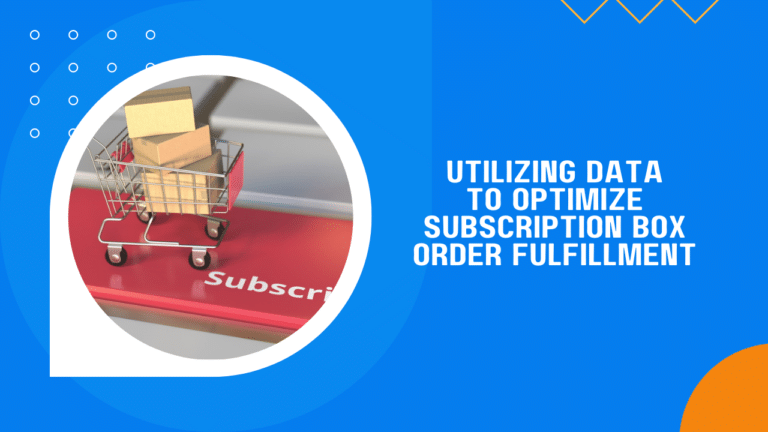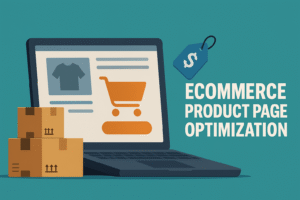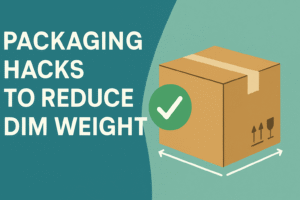Subscription boxes have become increasingly popular in recent years, offering customers a convenient and personalized way to discover and enjoy new products. However, the success of a subscription box business revolves around not only customer acquisition but also on customer retention.
Optimizing the subscription box order fulfillment process and improving customer retention rates are essential for businesses to succeed in this competitive industry.
One of the most powerful tools available to subscription box businesses for achieving these goals is data. By collecting and analyzing data on customer behavior and preferences, businesses can gain valuable insights into how to improve their operations and enhance the customer experience.
The Importance of Data in Subscription Box Fulfillment and Customer Retention
If you run a subscription box business, data should be at the forefront of your mind. Data can be used to optimize your subscription box fulfillment process and improve customer retention rates. But why is data so important for subscription box businesses?
Firstly, data can help you gain insights into customer behavior and preferences. By collecting and analyzing customer data, you can learn what your customers like and don’t like about your products and services. This information can be used to improve your subscription box offerings and make your customers happier.
Secondly, data can help you track your performance and identify areas for improvement. By monitoring key performance indicators (KPIs) such as customer churn rate, you can see how well your business is doing and where you need to focus your efforts.
Thirdly, data can help you personalize the customer experience. By collecting customer data such as their purchase history and preferences, you can tailor your subscription box offerings to their individual needs and wants. This can increase customer satisfaction and retention rates.
So, what types of data should you be collecting and analyzing? There are a few key types of data that are particularly useful for subscription box businesses:
Customer data: This includes information about your customers such as their demographics, purchase history, and feedback.
Sales data: This includes information about your sales performance such as revenue, conversion rates, and average order value.
Operational data: This includes information about your fulfillment process such as shipping times, order accuracy, and returns.
By collecting and analyzing these types of data, you can gain a better understanding of your business and your customers, and use this knowledge to optimize your subscription box fulfillment process and improve customer retention rates.
In the next section, we’ll go into more detail about how to collect and analyze data for your subscription box business.
Collecting and Analyzing Data for Subscription Box Businesses
As a subscription box business owner, collecting and analyzing data is critical to the success of your business. The data you collect can help you understand your customers better, improve your fulfillment process, and increase customer retention rates.
Collecting Data
Collecting data is the first step to using it to optimize your subscription box fulfillment process and improve customer retention rates. There are many different types of data that you can collect as a subscription box business. Some of the most important data points to collect include:
- Customer Data: Customer data is information about your customers, including demographics, purchase history, and subscription details. This data is critical to understanding your customers and personalizing their experience. You can collect this data by asking customers to fill out surveys or questionnaires when they sign up for your subscription service. You can also collect data through social media, website analytics, or customer service interactions.
- Sales Data: Sales data is information about your sales performance, including revenue, conversion rates, and average order value. This data is important to understand your business’s financial performance and identify trends in sales. You can collect this data using analytics tools such as Google Analytics or Mixpanel, which can track sales data on your website, mobile app, or other sales channels.
- Operational Data: Operational data is information about the fulfillment process, including shipping times, inventory levels, and fulfillment errors. This data is important to optimize your fulfillment process and reduce errors. You can collect this data by tracking your fulfillment process using software or spreadsheets.
Analyzing Data
Once you’ve collected your data, it’s time to analyze it to gain insights into customer behavior and preferences. Some of the most important things to look for when analyzing your data include:
- Trends: Look for patterns in your data that can help you identify trends over time. For example, if you notice that certain products are more popular during certain seasons, you can adjust your inventory levels and marketing campaigns accordingly. You can also identify trends in customer behavior, such as when they’re most likely to make a purchase or when they’re most likely to cancel their subscription.
- Customer Behavior: Use your data to identify patterns in customer behavior, such as when they’re most likely to make a purchase or when they’re most likely to cancel their subscription. This can help you tailor your marketing campaigns and improve your retention rates. You can also analyze customer feedback and reviews to identify areas for improvement and understand their needs better.
- Fulfillment Metrics: Analyze your fulfillment metrics, such as shipping times and accuracy, to identify areas for improvement. Use this information to optimize your fulfillment process and reduce errors. By improving your fulfillment process, you can increase customer satisfaction and retention rates.
Using Analytics Tools
There are many different analytics tools available that can help you collect and analyze data for your subscription box business. Some of the most popular tools include:
- Google Analytics: This free tool from Google can help you track website traffic, user behavior, and conversion rates. You can use Google Analytics to track the performance of your subscription box website and identify opportunities for improvement.
- Mixpanel: Mixpanel is an analytics tool designed specifically for mobile apps and can help you track user behavior and engagement. If you have a mobile app for your subscription box business, Mixpanel can help you understand how customers are using your app and identify opportunities for improvement.
- Kissmetrics: Kissmetrics is a tool designed to help businesses track user behavior across multiple platforms, including websites, mobile apps, and email.
Using Data to Address Fulfillment Challenges
Subscription box fulfillment can be a challenging process, and even small mistakes can lead to unhappy customers and lost revenue. Fortunately, data can be a valuable tool for identifying and addressing fulfillment challenges. In this section, we’ll explore some of the most common challenges and how data can be used to overcome them.
One of the biggest challenges in subscription box fulfillment is packaging and shipping. Customers expect their boxes to arrive quickly, safely, and in good condition, and any problems in the packaging or shipping process can lead to dissatisfaction. By analyzing shipping data and customer feedback, subscription box businesses can identify common issues and make adjustments to improve the process. For example, if customers frequently report damaged products, the business can experiment with different packaging materials or adjust the packing process to better protect the products.
Another common fulfillment challenge is accuracy. Subscription box businesses must ensure that the right products are included in each box, and that the boxes are delivered to the correct address. Data can be used to track accuracy metrics and identify areas for improvement. For example, if a high percentage of boxes are returned due to incorrect addresses, the business can implement more stringent address verification processes.
Finally, data can be used to optimize the logistics of subscription box fulfillment. By analyzing shipping data, businesses can identify patterns and optimize routes to reduce shipping times and costs. They can also use data to predict demand and ensure that they have enough inventory on hand to meet customer needs.
Leveraging Data to Personalize the Customer Experience
When it comes to subscription box businesses, personalization is key to improving customer retention rates. Customers want to feel like their subscription is tailored to their unique preferences and needs, and data can help make that happen.
To begin with, it’s important to collect and analyze customer data to gain insights into their preferences and behavior. This includes data such as customer demographics, purchase history, and feedback. By understanding your customers’ needs and preferences, you can tailor your subscription box to their interests and increase the likelihood of them staying subscribed.
One way to use data to personalize the customer experience is by offering tailored product recommendations. By analyzing purchase history and customer behavior, you can make personalized product recommendations that will resonate with your customers. This will not only increase the likelihood of repeat purchases, but also make your customers feel valued and understood.
Another way to personalize the customer experience is by offering customized packaging. By collecting data on your customers’ preferences, such as their favorite colors and design styles, you can create customized packaging that will delight them and make them feel special. This will help differentiate your subscription box from others in the market and increase customer loyalty.
Finally, data can be used to create personalized marketing campaigns and promotions. By analyzing customer data, you can create targeted marketing campaigns that will resonate with your customers and increase the likelihood of them staying subscribed. For example, if you notice that a particular customer is interested in a specific product category, you can create a targeted marketing campaign around that category to increase the likelihood of them making a purchase.
Best Practices for Using Data to Optimize Subscription Box Fulfillment and Improve Customer Retention
When it comes to optimizing subscription box fulfillment and improving customer retention rates, data can be a powerful tool. However, it’s essential to use data effectively and efficiently to achieve the desired results. In this section, we’ll discuss some best practices for using data to optimize subscription box fulfillment and improve customer retention rates.
Identify Key Performance Indicators (KPIs) and Set Goals
The first step in using data to optimize subscription box fulfillment and improve customer retention rates is to identify key performance indicators (KPIs) that are relevant to your business. These KPIs should be specific, measurable, and aligned with your business goals. Some common KPIs for subscription box businesses include retention rate, customer acquisition cost (CAC), and customer lifetime value (CLV).
Once you have identified your KPIs, set goals for each one based on industry benchmarks and your business objectives. Regularly track and analyze your KPIs to determine whether you’re meeting your goals and adjust your strategies accordingly.
Collect and Analyze Data Regularly
To effectively optimize subscription box fulfillment and improve customer retention rates, it’s crucial to collect and analyze data regularly. This includes both quantitative data, such as sales and subscription data, and qualitative data, such as customer feedback and reviews.
Use analytics tools, such as Google Analytics, Mixpanel, and Kissmetrics, to collect and analyze data on a regular basis. This will help you identify trends, patterns, and areas for improvement in your subscription box business.
Use Data to Personalize the Customer Experience
Personalization is a critical component of improving customer retention rates. Using data, you can tailor the subscription box experience to each individual customer’s preferences and needs. For example, you can use customer data to offer personalized product recommendations, customize packaging, or provide exclusive content.
Analyze Customer Feedback and Reviews
Customer feedback and reviews can provide valuable insights into customer preferences and pain points. Regularly analyze customer feedback and reviews to identify areas for improvement in your subscription box fulfillment process. For example, if customers frequently complain about delayed shipments or damaged products, you can use this feedback to make improvements to your shipping and packaging processes.
Implement Effective Loyalty Programs
Loyalty programs can be a powerful tool for improving customer retention rates. Using data, you can create and implement effective loyalty programs that reward and retain customers. For example, you can offer discounts or free gifts to customers who refer friends, or provide exclusive content to long-time subscribers.
By following these best practices, you can use data to optimize order fulfillment and improve customer retention rates. However, it’s important to regularly track and analyze your KPIs and adjust your strategies accordingly to achieve the desired results.
The Power of Data
Subscription boxes are a popular and growing trend, but success in this industry requires more than just a great product. By using data to optimize the subscription box fulfillment process and improve customer retention rates, businesses can gain a competitive edge and create a loyal customer base.
In this article, we’ve explored the importance of data in subscription box businesses, the types of data to collect and analyze, and best practices for using data to optimize subscription box fulfillment and improve customer retention rates. We’ve also discussed how data can be used to address common fulfillment challenges, personalize the customer experience, and create effective loyalty programs.
Real-world examples have shown how data-driven strategies can lead to significant improvements in customer retention rates and overall business success. By following the best practices outlined in this article, subscription box businesses can use data to gain a competitive edge and create a subscription box experience that keeps customers coming back.









